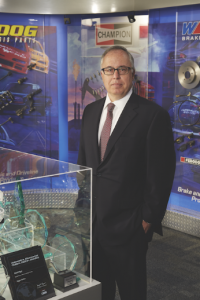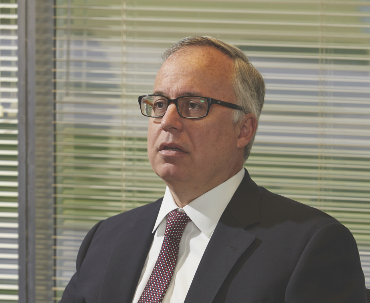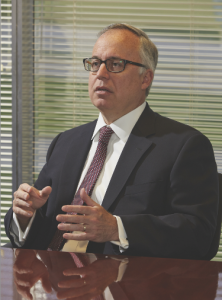Babcox Media recently sat down one-on-one with Daniel Ninivaggi prior to the start of this year’s AAPEX. Ninivaggi is Co-Chief Executive Officer and a member of the Board of Directors of Federal-Mogul Holdings Corp., and Chief Executive Officer, Federal-Mogul Motorparts. He joined Federal-Mogul in 2010, serving as a member of the Board of Directors. In February 2014, he was appointed to his current position. We asked him about the company’s business strategy, products and his goals as CEO.
How do see Federal-Mogul Motorparts’ extensive portfolio of brands and products positioned and evolving in the marketplace today?
Our objective is to be the highest quality and most respected supplier to the global aftermarket. We have a 116-year history. We’re very strong in our core product categories, but we think there’s an opportunity to get bigger; that is, deeper in our core categories, to move into more product lines and certainly become more global.
The business now is mainly in North America and Europe. Europe is actually about even with North America in revenue as a result of the Honeywell brake acquisition, but the history and legacy of the company is basically North American brands. But when you look at Asia, Latin America, Eastern Europe – notwithstanding the troubles there right now — that’s where the growth is coming from. The Chinese car parc is going to double in the next seven years. Latin America is growing 5 to 6 percent per year. So, we want to become more global.
Additionally, when you look at the aftermarket supply base, it’s very fragmented. We think there’s an opportunity to become larger and much more global on the product side.
The Honeywell brake acquisition gave us another plant in China. We now have 150 people on the ground in Shanghai and two large friction plants. We also have a wiper plant there. So, we’re building out the business aggressively, and I think it’s a good opportunity.
In North America and Europe, as you can see from the Affinia and Honeywell acquisitions, we’re strengthening our core product lines. We’re also getting into some complementary product lines, like filters.
How does the recent name change to Federal-Mogul Motorparts reflect and support your growth strategy in North America and globally?
We had to create a separate identity, within the company and outside. This is a different company from the Powertrain, or OE-centered, business. It’s important to create that identity. But above all, we want to be able to focus on our product brands. We have 20 product brands that are very well known in the aftermarket. They’re going to be our real focus.
And that filter launch, will that be branded Champion?
Yes. The plan is to expand Champion into a multi-category global brand and be able to leverage it, which will give us the resources to invest more in the brand. We already have Champion-branded wipers and filters. We have Champion-branded brake fluid in various parts of the world. We need to bring it all together to offer a broad range of service products under one umbrella.
Federal-Mogul Holdings recently announced that the Motorparts business would be separated from the Powertrain business and be a standalone company. How does this announcement affect your business strategy going forward?
The most important aspect of the internal separation we initiated in 2012 is that it has provided each business with the clear management focus to pursue its respective business strategy. But we also think Motorparts as a standalone company can grow faster. Motorparts is definitely a growth play, whereas the Powertrain business is a steady-as-she-goes, traditional OEM supplier. They’re growing in different ways, but it would be confusing and counter-productive to have the two businesses together in the long-term.
What are your priorities for growing Motorparts?
 You have to start with the best products, so quality and innovation are key. If you have great products, service providers will want them. You also have to communicate the value proposition and what makes the products great. And then it’s coverage and service: You have to have the right inventory in the right places and offer world-class customer service, including great delivery. The principal reason we’re building out our distribution in North America is so we will have great coverage and customer service.
You have to start with the best products, so quality and innovation are key. If you have great products, service providers will want them. You also have to communicate the value proposition and what makes the products great. And then it’s coverage and service: You have to have the right inventory in the right places and offer world-class customer service, including great delivery. The principal reason we’re building out our distribution in North America is so we will have great coverage and customer service.
Do you have short- and long-term goals for yourself as CEO?
At the end of the day, if you are the highest quality, most respected supplier to the aftermarket, that says it all, right? That’s ultimately your goal. It’s a question of how you get there. And you get there, again, by having the best products, the best coverage and the best service. The value proposition of our brands has not always been well communicated through the channels. If you do all of those things well — great products, service and coverage – and you communicate those messages effectively, guess what? Everybody wins. Your customers are happy, you’re creating a lot of value for your employees and shareholders, and the business will grow profitably.
Recently you announced a broad-ranging initiative that’s called “Tech First,” that’s going to include an expanded team of technical product specialists, and “Market Connect,” that has field support vans and several technical support centers that are going to be located in key markets. Can you explain the strategy behind that initiative and provide an update on each element of that?
This goes to the communication aspect more than anything else. Over the years, we’ve relied on our distribution partners to not only sell our products but also to communicate the value proposition of our brands. In many cases they have done a good job. But we have cut back on our direct sales force, our technical people and our field people on the ground, and it’s time for us to reinvest in that. This is a service provider-focused company. We’ve got to be on the ground, directly communicating the value proposition of our products. We’ve got to take responsibility for that and are investing accordingly. We’ve placed a number of our initiatives under the “Tech First” umbrella. It’s really about re-doubling our efforts to engage with repair professionals and make sure they understand the value of our product lines and the meaning of our brands.
How do your distribution partners feel?
We all win if there’s real value in the product. I believe that every one of our channel partners would say that if you can demonstrate the value proposition of your brands, we’re happy because that means end customers are paying for a premium product, the market is more differentiated, it’s not commoditized and we’re adding value to the service provider. And that makes the service provider’s business more successful, and that success runs all the way up the chain.
We’re setting up technical support centers in major cities across North America. We already have build-outs taking place in New York, Chicago and Los Angeles, and we’ve identified sites in Baltimore, Dallas, Atlanta, South Florida, Detroit and St. Louis. The plan is to be in every major metro market with people on the ground and our expanded fleet of “Market Connect” training vans operating out of these centers to reach hundreds of repair businesses in each region. Our training van fleet will be growing from eight to about 50 by the end of next year and they’ll be manned by ASE-certified techs who will be working with customers and directly promoting our products. I believe our channel partners will be supportive because it gives them something to offer their customers.
We’re also investing in an entirely new IT system and additional field staff. And we’re making these investments not only in North America but in Europe and Asia as well.
Let’s talk about acquisitions. As you mentioned earlier, you recently acquired the Affinia chassis business and the friction business from Honeywell. How do these businesses enhance your brand portfolio globally and are there plans for future acquisitions?
We’re looking at growing organically as well as through acquisitions. Friction and steering and suspension are core product lines, and those acquisitions took strong businesses and made them even stronger. They broadened our customer base, brought us new supplier relationships and new technologies and, in some cases, new brands.
For example, Honeywell provided additional OE business and manufacturing and engineering capacity. It also gave us a great plant in Romania and one in China. That was a game-changer in terms of giving us access to low-cost capacity.
Where we can grow the business faster and better through an acquisition, we’ll pursue an acquisition. At the same time, I’m very comfortable building these capabilities on our own. We’ve got great engineering and manufacturing resources within the company, and there are very few product lines complementary to our existing products that we couldn’t build on our own.
The Auto Care Association had a recent study that showed e-tailing as the fastest-growing aftermarket retail sector, and they cited three product categories that are one half of e-tailing today. And Federal-Mogul is a major player of two of those, braking and ignition/engine. Does this growth in online commerce concern you at all?
Consumers are going on-line for more information and, if it makes sense, buying more items on-line. I expect that that on-line traffic will continue to grow. But I don’t think on-line is going to be a major growth play for the traditional aftermarket, because customer service and support are so important. Immediate availability is usually imperative for the service provider and consumer. So, no question, there will be customers who will go on-line for information. Our new IT platform will have B2B e-commerce capabilities but, more importantly, more and better information to support the customer both pre- and post-sale. It will have relevant parts information, training materials and a great catalog. We will have a much more robust on-line presence.
In terms of branding and rebranding, the Automotive Aftermarket Industry Association recently rebranded itself Auto Care Association. Do you feel the new brand is more representative of the organization’s role in our industry?
Whether you’re a manufacturer or distributor or wherever you are in the aftermarket, I think the focus on auto care makes sense because it defines our ultimate product. I think it was a smart decision.
You lead a global business. What characteristics are more important or are the most important to somebody who leads a global business?
I think now more than ever the market is just very dynamic, so you have to be able to adjust quickly; you’ve got to be nimble, and our company probably wasn’t nimble enough over the past several years. You’ve got to be able to react much more quickly to what’s going on in the market.
Our channel partners are the people on the front line. We need to support them, but also be more on the front line ourselves. That’s why we’re doing the “Tech First” initiatives. You’ve got to listen to what’s going on in the street and react quickly to it. So, a lot of what I’ve been doing the last 10 months is listening to customers and service providers. I’ve spent a lot of time with our customers in North America and Europe to gain a sense of what they are seeing and how we can be more effective as a company.
Where are you on import coverage?
You would think that as a company with a large market presence in Europe, that North American service providers and other customers would really rely on us for OE-quality parts for European vehicles. But the truth is, we haven’t done an effective job of leveraging our global capabilities. A simple example is our brake line: Our friction products are on the vast majority of OE platforms in Europe. You would think our European brake brands would resonate here, but we don’t sell them here. So, we’re bringing Ferodo, which is our main European brand, to North America and we’re going to promote it as the premium European vehicle brake pad – which it is. We are also looking at global opportunities for our Jurid brake products.
Our Powertrain business is more than half European. Our largest customers in Europe are BMW, Audi, Volkswagen and Mercedes. So, when we’re selling engine parts for those applications, nobody should be better than us. We should have a lot of credibility on the import side.
We do have great coverage on Asian vehicles, as well, but we’re not known for that. We’ve got to communicate our extensive coverage more effectively and make it clear that we have coverage for virtually all applications in North America and Europe. We should be able to use our global capabilities and, in particular, our European pedigree better in North America.
And by the way, our channel partners like that, too. They want to be relevant to the import specialist and they like the fact that we’re a global company.









